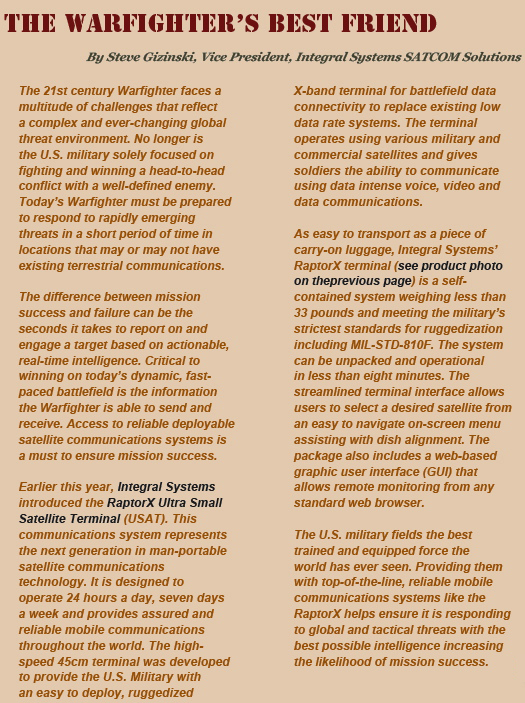Focus... Operational Situational Awareness
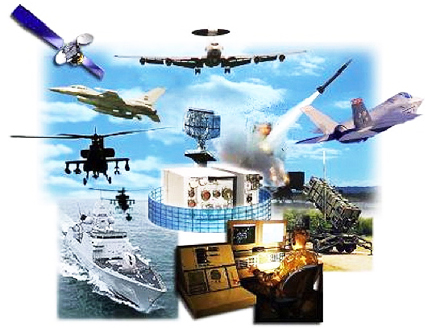 Increased complexities within the space environment are forcing an evolution from a single static perspective of Space Situational Awareness to a more comprehensive space system operations, segment defined, Situational Awareness (SA); space, ground, and system.
Increased complexities within the space environment are forcing an evolution from a single static perspective of Space Situational Awareness to a more comprehensive space system operations, segment defined, Situational Awareness (SA); space, ground, and system.
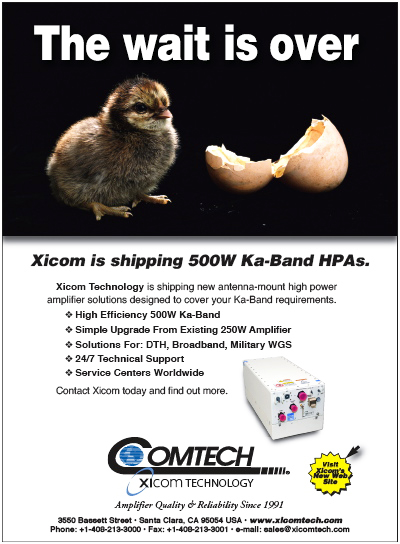
The topic of
Space Situational Awareness (
SSA) is not new; however, if you ask 10 people to define SSA, you will likely receive many different perspectives. Depending on the presenter, SSA can range from the monitoring of the space environment, to maintaining the
High Accuracy Catalog, to the monitoring of interference on
Military Satcom (
MILSATCOM) and
Commercial Satcom (COMSATCOM) links. Of course, there are other examples, but the point is clear.
Integral Systems has more than 25 years of experience within the satellite industry, working with military and commercial satellite operators to help them better understand their operational environments. Over the past 18 to 24 months, the company has seen a sharp increase in requests to provide a broader, albeit focused, operational picture to operators. After discussions with a number of customers and research on the subject, it became clear the concept of SSA was evolving from a very broad perspective into SA segments to analyze all aspects (space, ground, and system) that could affect the operation of a space system.
This space system focused, all-inclusive approach to the segments of SA is what the company refers to as “
Operational Situational Awareness” (
OSA). OSA provides the operator with an integrated space, ground, and system overview of the space system environment and delivers the ability to quickly and easily “drill down” into individual segments enabling an operator to take immediate action.
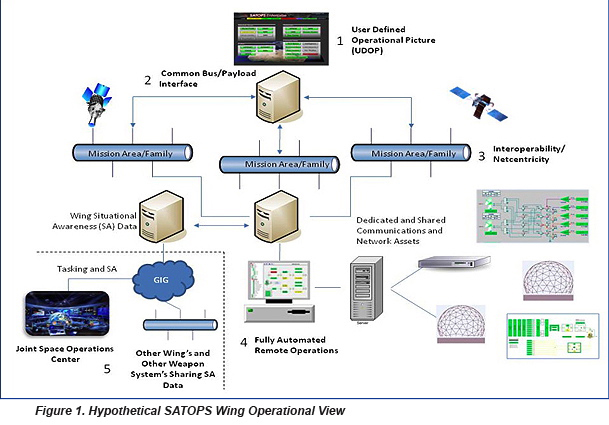
Integral Systems recently announced its
SATOPS Enterprise Architecture. Our powerful enterprise architecture provides satellite and space operators with a platform for OSA varying from a single echelon operation up through multi-level echelon operations. The architecture will include the entire enterprise by integrating mission-relevant, multi-source data from Integral Systems best-in-class products and technology, as well as third-party products and data sources.
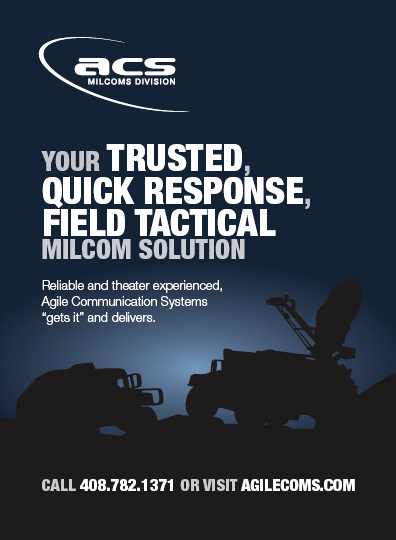
Components of the architecture include:
User Defined Operational Picture (UDOP);
thin client application;
common Telemetry, Tracking, and Commanding interface;
underlying Interoperable/Netcentric core architecture;
automated monitor and control of all remote antenna systems; and
real-time, SA data sharing through the Global Information Grid (GIG), to and from the JSpOC, other SATOPS Wings, and adjacent weapon systems. The
50th Space Wing (SW) is used as a representative example; however the concept is applicable to any operational unit. (See
Figure 1)
1) UDOP:
The UDOP is the primary access to OSA information. The user can select what data to display and how to arrange it, since the main features are data source independence and web-based access. Figure 2 on the next page is a screen shot from Integral System’s Webic thin client that represents a possible UDOP at the 50th Space Wing located at Schriever AFB, CO. The operator has access to all the mission areas under the wing; real-time status of the dedicated and share networks, including commercial networks used by the Space Based Space Surveillance system. A host of external information is available to the operator support decision making, including base readiness, weather, space environment, and information from other space agencies. Additionally, the user can perform administrative functions such as Crew Force management.
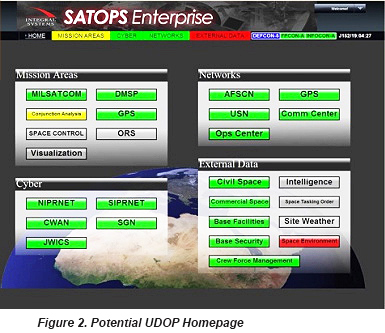 2) Common TT&C Interface
2) Common TT&C Interface:
Currently, each command and control system deployed throughout AFSPC has a different look and feel from the operator’s perspective. AEP uses one product, SBIRS uses another, MMSOC uses yet another, and MILSATCOM uses Integral Systems’ EPOCH. Leveraging a thin client as described in the previous section, coupled with an automation language, such as Integral System’s Task Automated Operations (TAO), that executes spacecraft and ground procedures, AFSPC could migrate to a common user interface quite easily. This approach could be used to drive procedures within the legacy systems across AFSPC.
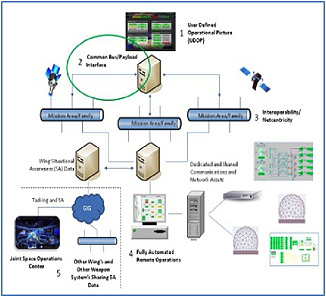 The best approach is to provide “selectable” automation, which lets the operator literally “dial-in” the level of automation for each operation. Ultimately, introducing as much automation as possible will reduce operator workload, freeing up resources to focus on the mission at hand.
3) Interoperability/Netcentricity
The best approach is to provide “selectable” automation, which lets the operator literally “dial-in” the level of automation for each operation. Ultimately, introducing as much automation as possible will reduce operator workload, freeing up resources to focus on the mission at hand.
3) Interoperability/Netcentricity:
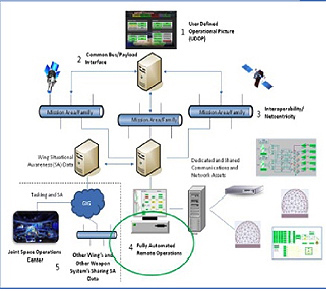 The reality of the existing AFSPC architecture is that systems are not only disparate technically, but also are funded from different budgets or program elements. This creates a challenge as OSA is implemented, but there are ways to work through this situation. In the short term, it is not necessary that each mission area operate on the exact same architecture, but it is important that each are interoperable through the use of well-documented Application Programmer Interfaces (API) and perhaps migrating to serviced-based/enterprise architectures that allow for services from one system to communicate with another, and then communicate with common user interface layer described in item 2.
The reality of the existing AFSPC architecture is that systems are not only disparate technically, but also are funded from different budgets or program elements. This creates a challenge as OSA is implemented, but there are ways to work through this situation. In the short term, it is not necessary that each mission area operate on the exact same architecture, but it is important that each are interoperable through the use of well-documented Application Programmer Interfaces (API) and perhaps migrating to serviced-based/enterprise architectures that allow for services from one system to communicate with another, and then communicate with common user interface layer described in item 2.
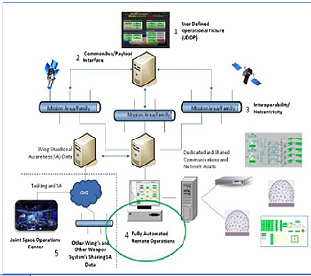 4) Automated Remote Antenna Systems
4) Automated Remote Antenna Systems:
Within the 50th SW alone, remote networks include the AFSCN, dedicated GPS Ground Antenna, and the GPS L-band Monitor Stations. The GPS sites are fully automated today, and transitioning the AFSCN to fully automated operations is achievable in the short term, coincident with RTS Block Change (RBC) rollout. We define fully automated AFSCN ground system operations as hands free, lights out, with all remote operations centralized within a common SOC. The primary issue in achieving full automation is to allow the satellite operator to update their satellite configurations, which sets up the site for a specific satellite vehicle. Today, many satellite configurations still require manual intervention.
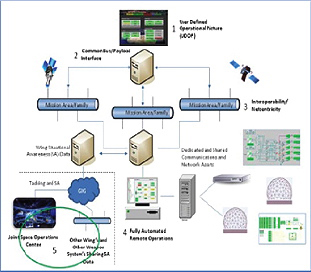 5) Real-time, Shared SA Data
5) Real-time, Shared SA Data:
The most critical aspect of the SATOPS Enterprise Architecture is the ability for the JSpOC, other Space Operations Wings (50th and 460th), other space agencies (NRO, NASA, and NOAA), launch wings (30th and 45th), and other weapons systems (i.e., Defensive Counter Space) to share all situational awareness information up through various echelons or across agencies, enabling effective, timely decision making at all levels in near real time.
Each wing, mission area, or even an individual system could be its own “Data Center” connected through the various networks (i.e., SIPRNET) and available on the GIG. Employing a Data Center concept, along with potential Mesh/Cloud architectures, the JSpOC will have access to the right information, at the right time, without hosting all the data at Vandenberg AFB. Conceivably, the JSpOC could have a minimal set of tools for performing various analysis functions, and a thin client for access to wing-level, mission area, or even specific weapon system OSA information. This includes the status of the space effects. As a two-way operation, the JSpOC’s Data Center would also publish awareness information for consumption across the AFSPC enterprise and other communities.
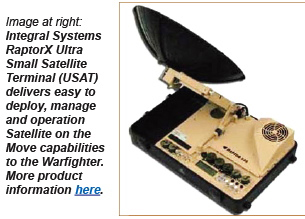
As space systems, from launch to disposal, and their related environments become more complex, operators must have a complete picture of their operation. OSA, as we have presented it, provides operators with the tools needed to easily monitor and manage their space system(s), as well as the ability to quickly respond at all levels when issues arise. This new, expanded capability ensures that the nation’s critical satellite infrastructure is running at peak performance.
